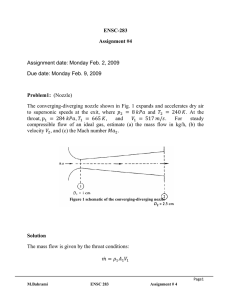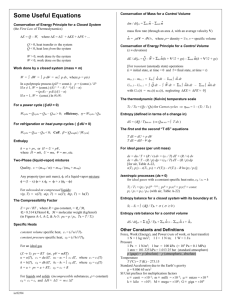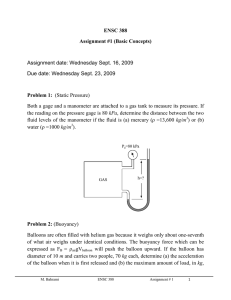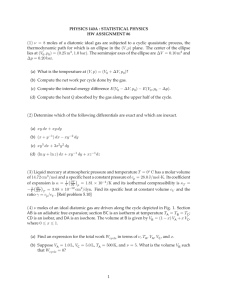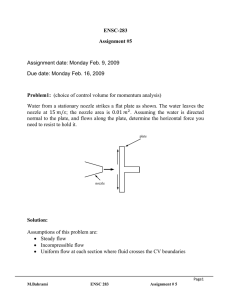ENSC 461 Assignment #5 (Exergy)
advertisement
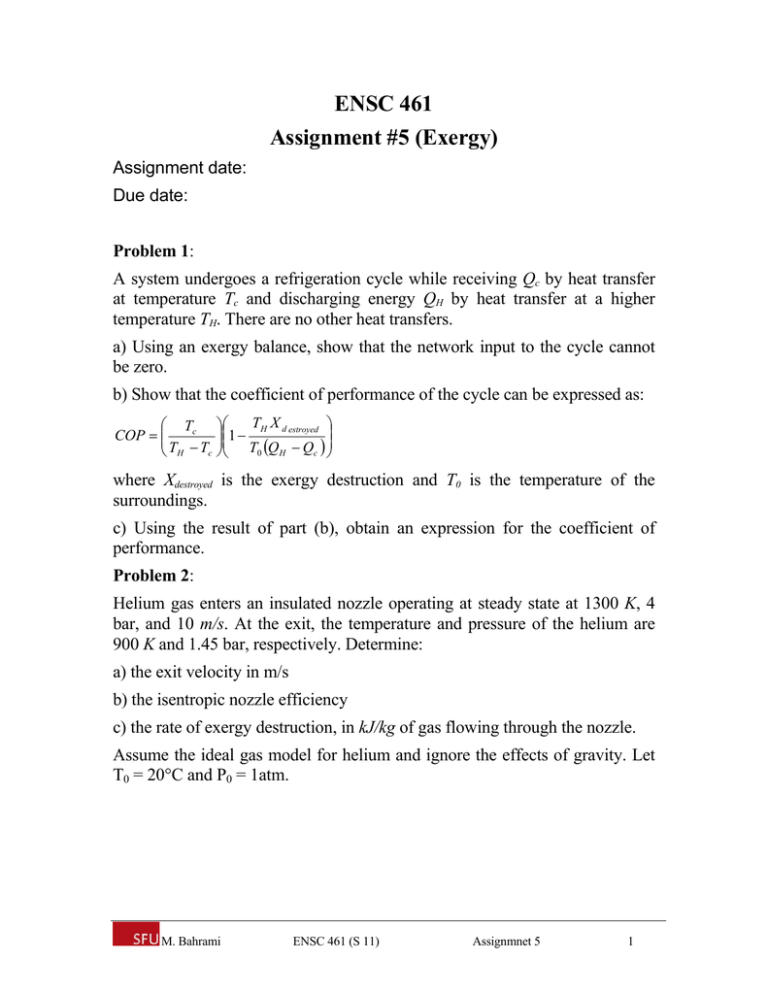
ENSC 461 Assignment #5 (Exergy) Assignment date: Due date: Problem 1: A system undergoes a refrigeration cycle while receiving Qc by heat transfer at temperature Tc and discharging energy QH by heat transfer at a higher temperature TH. There are no other heat transfers. a) Using an exergy balance, show that the network input to the cycle cannot be zero. b) Show that the coefficient of performance of the cycle can be expressed as: Tc COP TH Tc TH X d estroyed 1 T0 QH Qc where Xdestroyed is the exergy destruction and T0 is the temperature of the surroundings. c) Using the result of part (b), obtain an expression for the coefficient of performance. Problem 2: Helium gas enters an insulated nozzle operating at steady state at 1300 K, 4 bar, and 10 m/s. At the exit, the temperature and pressure of the helium are 900 K and 1.45 bar, respectively. Determine: a) the exit velocity in m/s b) the isentropic nozzle efficiency c) the rate of exergy destruction, in kJ/kg of gas flowing through the nozzle. Assume the ideal gas model for helium and ignore the effects of gravity. Let T0 = 20°C and P0 = 1atm. M. Bahrami ENSC 461 (S 11) Assignmnet 5 1 Solution, Problem 1: TH QH Wcycle = QH - QC Refrigerator QC TC Assumptions: 1) The system shown undergoes a refrigeration cycle 2) QC and QH are the only heat transfers and are in the directions of the arrows 3) Tc and TH are constant and TH > TC and the surroundings’ temperature is T0. Analysis: a) An exergy balance for the cycle reads: T X cycle 1 0 Tc T Qc 1 0 TH QH Wcycle P0 V X destroyed 0 0 where ∆Xcycle and ∆V are zero for a cycle. Introducing the energy balance, QH Wcycle Qc Since the work is being done on the cycle, it should be considered negative. We get: T 0 1 0 Tc T Qc 1 0 TH 1 1 T0 TH Tc Wcycle Qc Wcycle X destroyed T Qc 0 Wcycle X destroyed TH (1) Solving for Xdestroyed, and setting Wcycle to zero. M. Bahrami ENSC 461 (S 11) Assignmnet 5 2 1 T 1 X destroyed T0 Qc 0 Wcycle X destroyed 0 T Tc TH H 0 0 0 impossible! 0 Thus, Wcycle cannot be zero! b) Solving Eq. (1) for COP, one finds: COP Qc Wcycle TH Tc TH Tc W X Qc cycle destroyed TH T0 Tc TH X destroyed Qc 1 COP Wcycle TH Tc T0Wcycle Tc T T c H T X 1 H destroyed T0 QH Qc c) From the result of part b), COP increases as Xdestroyed 0. Thus, when Xdestroyed = 0: Tc COPmax TH Tc As expected. Solution, Problem 2: T P1 = 4 bar T1 = 1800 K T2 = 900K P2 = 1.45 bar T1 = 1300K P2 = 4 bar V1 = 10 m/s P2 = 1.45 bar 2 2S Assumptions: 1) The control volume shown is at steady-state 2) No work or heat transfer occurs in the c.v. shown 3) Potential energy effects are negligible. 4) Helium is modeled as ideal gas. 5) the environment is at T0 = 20C and P0 = 1 atm. Analysis: Energy balance for the nozzle at steady-state reduces to: M. Bahrami ENSC 461 (S 11) Assignmnet 5 3 s V 2 V22 0 Q cv W cv m h1 h2 1 2 0 gz 0 (1) V2 V12 2h1 h2 For monatomic gases, such as He, Ne, and Ar, c p over a wide range of temperature range is very nearly equal to 5/2 R . Thus, h1 – h2 = cp (T1 – T2) and: 2 1kg.m / s 2 8314 N .m m V2 10 2 2.5 1300 900 s 4.003 kg.K 1N m 2038 s To determine the isentropic nozzle efficiency requires the temperature at state 2s. With k = 1.667, we have: P T2 s T1 2 P1 k 1 k 0.667 1.45 1.667 1300 866.2 K 4 Then with Eq. (1) V2 s V12 2h1 h2 s V12 2c p T1 T2 s 2122 m s The isentropic nozzle efficiency is: 2 nozzle V22 / 2 2038 2 0.922 V2 s / 2 2122 92.2% The exergy destruction given by: X destruction m S gen T0 m No heat transfer and work transfer occurs in the nozzle, thus an entropy balance gives: X destruction m T P T P T0 s 2 s1 T0 c p ln 2 R ln 2 T0 R 2.5 ln 2 ln 2 T1 P1 T1 P1 kJ 8.314 kJ 900 1.45 2.5 ln ln 293 58.1 1300 4 kg 4.003 kg.K M. Bahrami ENSC 461 (S 11) Assignmnet 5 4

